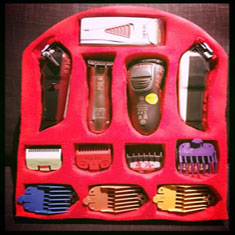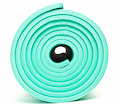What is Closed-Cell Polyethylene Foam & its Benefits

It’s no secret that closed-cell foam is one of the most versatile materials used by man. It has a wide variety of applications and benefits which we’re going to explore now. But before we start, please note that we offer a vast range of foams, including closed-cell foams. We can cut them to any size or shape with any density. If you would like a no-obligation chat about what you need and what we can supply you with, feel free to contact our team for more info. Our experienced team can cut your foam precisely and accurately, so it’s perfect for your project. Even if you haven’t had much exposure to foam products, Polyethylene closed-cell foam is one of those products that you’ll recognise if you see it. It’s relatively rigid to the touch, and we sell it with or without self-adhesive backing. Let’s take a look at what you need to know about one of the most versatile foams - polyethylene closed-cell foam. What is polyethylene closed-cell foam used for?Closed-cell foam is also known as polyethylene foam. It’s constructed of uniform cells that are sealed shut so neither water nor air can pass through. It’s more rigid than what you find with an open-cell foam which can take on water. Closed-cell foam is shock-resistant, a vibration absorber and offers thermal insulation. Polyethylene is a durable foam that is also available in a flame retardant version, so it can also be used inside the home. It’s important to note that closed-cell foam is also flexible, wipeable, moisture resistant and waterproof. It comes in various forms, including EVA foam, SBR foam rubber, polyethylene foam, and neoprene foam. Compared to open-cell foams – it won’t take on water. Open-cell foams can absorb water as they don’t have cells sealed from each other but are more like a sponge. What is polyethylene closed-cell foam used for?Ideal for use in both commercial and personal projects, it’s a product you will see almost everywhere you look, without realising what it is. Typical closed-cell items are yoga mats, swim noodles, cosplay, medical components, and it is also found in building and caravan insulation. It’s easy to make, cut and use and is suited to all kinds of projects, including creative projects, boat projects, home projects and caravan projects. It’s available in a wide range of colours and densities. We can supply cut to size closed cell foam. 

Polyethylene is a foam well suited for use as packaging for musical instruments, thermal insulation, the shock-absorbent that you’d find in crash helmets and even masonry supplies. It’s not likely to be used in upholstery unless it’s been specially treated. This is because it’s typically not fire retardant and does not comply with UKFR – UK Fire Regulations. However, many foam manufacturers can make fire retardant polyethylene by adding something extra to it, and we can do this too. So if you’re looking for fire retardant polyethylene closed-cell foam, get in touch, and we can arrange it for you. You may also have seen it in the form of yoga rollers and kneeling pads. Not only is it lightweight and flexible, but It’s wear and tear-resistant, so it is used in many different ways. What does polyethylene closed-cell foam look like?What makes polyethylene what it is, is the closed-cell structure. Tiny bubbles that are stuck to each other but closed off make up the structure. The result is a water-resistant material that’s rigid and is extra strong compared to the open-celled type of foam. When it’s not in its foam form, polyethylene is used as trash bags, containers for milk and chemicals such as oil. It’s also possible to laminate polyethylene to make it stronger with more protection. An example of this would be in the form of a bodyboard used at the seaside. What are the advantages of using polyethylene closed-cell foam?Other advantages of polyethene foam include being resistant to petroleum products and solvents and being antimicrobial, so you won’t find bacteria, mildew, or mould growing on it. If you press it down, it will return to its original form. All these characteristics are what make it so versatile in application, and it’s also possible to customise with additives and make it fire retardant and anti-static. The anti-static form of polyethylene is typically used for the transportation and packaging of delicate electronic instruments. The foam can disperse the electrostatic charges that may form when in contact with the components or during their movement. You’ll generally find polyethylene in a sheet or plank form, and these can be easily cut to fit the needs for packaging and casing. In addition to providing security, they can be good shock absorbers for transporting and storing items. Fortunately, closed-cell foam is very good at resisting moisture and providing thermal insulation, so it’s the perfect packaging material. You may also see polyethylene in very thin sheets used to wrap around pipes to insulate them against both heat loss and freezing. 

You’ll have seen the pool noodle by the pool, and it’s probably one of the most recognisable forms of this foam. Quite often, bolsters are also made from this foam which is used to give extra comfort. The crash pads used by high jumpers, climbers and gymnastics are also made from polyethylene closed-cell foam. Another additive that can be used with polyethylene foam is that of dyes. You may recall seeing it in white, black, red, yellow, green or blue. Polyethylene is one of the most versatile foam products available. It can be customised to suit your needs, and this makes its applications far broader. If you’re looking for polyethylene closed-cell foam, get in touch and tell us what you’re looking for. We can arrange for it to be cut to the size or shape you require. What are the benefits of closed-cell foams?Closed-cell foam offers many benefits, which is why you’ll see it being used daily. Waterproof and mould resistant – this foam won’t allow water or air to pass through it. This means it offers sealed protection against anything like mould, rot, bacteria or even mildew. It’s wipeable and can be used as a barrier against moisture. Thermal proof – the closed-cell foam can withstand temperatures and protect against them – from -60c to 90c. This feature means it’s excellent for insulating buildings and being used in extreme climates such as deserts etc. Durable with a long lifespan – it’s not easy for the closed-cell foam to deteriorate. You’re not going to get a lot of dry rot with this material. It will last for years and is used to insulate homes as it will last the life span of the building: this saves money, time and trouble. Buoyant - excellent for pool noodles, water park mats, boats and is popular in the watersports and marine industries. Strong – not only is the closed-cell foam firm, but it’s also lightweight and resistant to wear and tear. This means it’s durable but with rigidity and is excellent for packaging. Feel free to contact us to discuss any of your requirements. |




